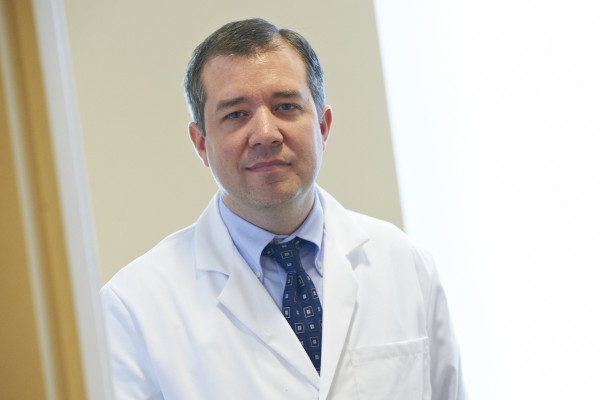Oncology
Non-Small Cell Lung Cancer
Promising Research Directions: The Future of Non–Small Cell Lung Cancer Treatment
Overview
The treatment of non–small cell lung cancer (NSCLC) has advanced dramatically in recent years with the introduction of novel targeted agents and immunotherapies. Areas of interest for the future include investigations into the application of novel therapies to earlier stages of disease.
Where do you see potential to advance the treatment paradigm in NSCLC?
Jeffrey Crawford, MD
|
|
“A big part of the future of NSCLC therapy will involve clinical trials in the population of patients with earlier-stage disease who are potentially curable with the addition of targeted therapy or immunotherapy.”
A key future direction of therapy will be to take what we have learned from the treatment of patients with advanced disease and the identification of novel agents and apply it to patients with earlier-stage disease, specifically those with resectable disease. Thus, it will be important to obtain molecular information on early stage patients and apply that in the surgical setting.
There are some early signs of success on this front. For example, in the ADAURA study, adjuvant osimertinib, a third-generation EGFR inhibitor, demonstrated a 79% reduction in the risk of disease recurrence or death compared with placebo in patients with early stage, EGFR mutation–positive NSCLC (ie, surgically resected stage IB-IIIA). We do not have overall survival data yet, but this study showed that strategies that are effective in advanced disease may also be effective in earlier stages of lung cancer. Such results may be paradigm changing because they suggest that broad molecular testing should be done in the surgical population. Thus, it behooves us to make sure that all patients who are undergoing surgery get tested for EGFR mutations at the very least. Hopefully, these results will play out with other agents as well.
Immunotherapy is also being evaluated in the surgical setting. Data from CheckMate-816 indicate that neoadjuvant nivolumab significantly adds to the pathologic complete response rate (24% vs 2.2% with chemotherapy alone) in patients with resectable NSCLC. We have also seen interim results of the phase 3 IMpower010 study in which adjuvant atezolizumab was associated with a significant improvement in disease-free survival compared with best supportive care in patients with stage II to IIIA NSCLC. Thus, a big part of the future of NSCLC therapy will involve clinical trials in the population of patients with earlier-stage disease who are potentially curable with the addition of targeted therapy or immunotherapy.
Gregory J. Riely, MD, PhD
|
|
“Understanding why and how patients become resistant to some of the newer agents, and figuring out ways to target that resistance, will really help to lead us to the next generation of therapies to care for our patients with NSCLC.”
I completely agree with Dr Crawford that the curative disease setting is one of the most important areas of investigational focus right now. Ultimately, our goal is to cure people of lung cancer, and the study of moving these therapies up to earlier stages of disease is a part of that pursuit.
We also look to continue to improve outcomes for our current patients with stage IV lung cancer. I think that there is a need to further our understanding of the mechanisms of resistance to targeted therapies. Such an understanding will allow us to design novel therapeutic approaches for these patients. We have seen a tremendous advance in the treatment of patients with EGFR-mutant lung cancer, now having a median overall survival of more than 3 years in frontline trials. That is clearly dramatic progress from where we were 10 or 15 years ago. And that progress came from understanding why and how patients became resistant to first-line, first-generation EGFR tyrosine kinase inhibitors such as erlotinib and gefitinib. We need to continue with such efforts to further our understanding of the mechanisms of resistance to the targeted therapies that are in use today, right now. Understanding why and how patients become resistant to some of the newer agents, and figuring out ways to target that resistance, will really help to lead us to the next generation of therapies to care for our patients with NSCLC.
Bruce E. Johnson, MD
|
|
“One of the important revelations about the use of immunotherapy in those with NSCLC is the subset of patients treated with either single-agent ICI therapy or 2 ICIs in combination who appear to be disease free at 5 years. We need more work to determine how to identify patients who will have these dramatic long-term responses to ICI therapy.”
One of the important revelations about the use of immunotherapy in those with NSCLC is the subset of patients treated with either single-agent immune checkpoint inhibitor (ICI) therapy or 2 ICIs in combination who appear to be disease free at 5 years. It depends on the definitions used, but, among all comers, a generous estimate would be that between 15% and 25% of these patients who start treatment initially will be disease free at 5 years. This is a finding that I never thought we would see in advanced NSCLC. The caveat is that we need more work to determine how to identify patients who will have these dramatic long-term responses to ICI therapy.
The leading predictive biomarkers are tumor mutation burden (TMB) and programmed cell death-ligand 1 (PD-L1). TMB is a measure of how many mutations are present, and higher numbers are associated with an increased response rate and patient outcome. A common cutoff point used for assessing TMB is 10 mutations per megabase, but this value will vary depending on how it is assessed and the particular trial in which the values are applied. Even though we use different cutoff points for percentage PD-L1 in clinical trials, it appears that the efficacy at various PD-L1 positivity levels is more of a linear function. For example, a study by Aguilar and colleagues reported that the overall response rates for patients with a PD-L1 tumor proportion score (TPS) of 90% or higher was 61% compared with 31% for those with a TPS of 50% to 89%. Similarly, patients with a PD-L1 TPS of 90% or higher had a significantly longer progression-free survival compared with those with lower PD-L1 levels (13.2 vs 3.7 months). Additional research is needed to elucidate how best to use these 2 predictive biomarkers, to help identify patients who will respond to ICI therapy.
Another area of investigation is the use of novel combination immunotherapies. There are a number of new agents that target different checkpoints such as TIM-3, LAG-3, and TIGIT, and there are ongoing studies designed to see whether combining different ICIs can improve clinical outcomes.
References
Aguilar EJ, Ricciuti B, Gainor JF, et al. Outcomes to first-line pembrolizumab in patients with non-small cell lung cancer and PD-L1 tumor proportion score >90%. J Clin Oncol. 2019;37(suppl 15):9111. doi:10.1200/JCO.2019.37.15_suppl.9111
ClinicalTrials.gov. A neoadjuvant study of nivolumab plus ipilimumab or nivolumab plus chemotherapy versus chemotherapy alone in early stage non-small cell lung cancer (NSCLC) (CheckMate 816). Accessed June 14, 2021. https://clinicaltrials.gov/ct2/show/NCT02998528
Herbst RS, Tsuboi M, John T, et al. Osimertinib as adjuvant therapy in patients (pts) with stage 1B-IIIA EGFR mutation positive (EGFRm) NSCLC after complete tumor resection: ADAURA. J Clin Oncol. 2020;38(suppl 18):LBA5. doi:10.1200/JCO.2020.38.18_suppl.LBA5
National Cancer Institute. Osimertinib improves survival in advanced lung cancer with EGFR mutations. Accessed June 14, 2021. https://www.cancer.gov/news-events/cancer-currents-blog/2019/osimertinib-lung-cancer-improves-survival-flaura
Neoadjuvant nivolumab plus chemotherapy increased pathological complete response rate in CheckMate-816 Lung Cancer Trial. News release. American Association for Cancer Research. April 10, 2021. Accessed June 14, 2021. https://www.aacr.org/about-the-aacr/newsroom/news-releases/neoadjuvant-nivolumab-plus-chemotherapy-increased-pathological-complete-response-rate-in-checkmate-816-lung-cancer-trial/
Pockley AG, Vaupel P, Multhoff G. NK cell-based therapeutics for lung cancer. Expert Opin Biol Ther. 2020;20(1):23-33. doi:10.1080/14712598.2020.1688298
Wakelee HA, Altorki NK, Zhou C, et al. IMpower010: primary results of a phase III global study of atezolizumab versus best supportive care after adjuvant chemotherapy in resected stage IB-IIIA non-small cell lung cancer (NSCLC). J Clin Oncol. 2021;39(suppl 15):8500. doi:10.1200/JCO.2021.39.15_suppl.8500
Yuan M, Huang L-L, Chen J-H, Wu J, Xu Q. The emerging treatment landscape of targeted therapy in non-small-cell lung cancer. Signal Transduct Target Ther. 2019;4:61. doi:10.1038.s41392-019-0099-9













